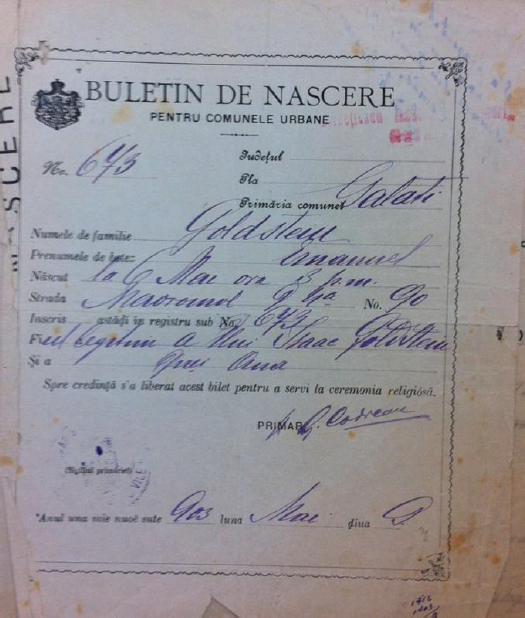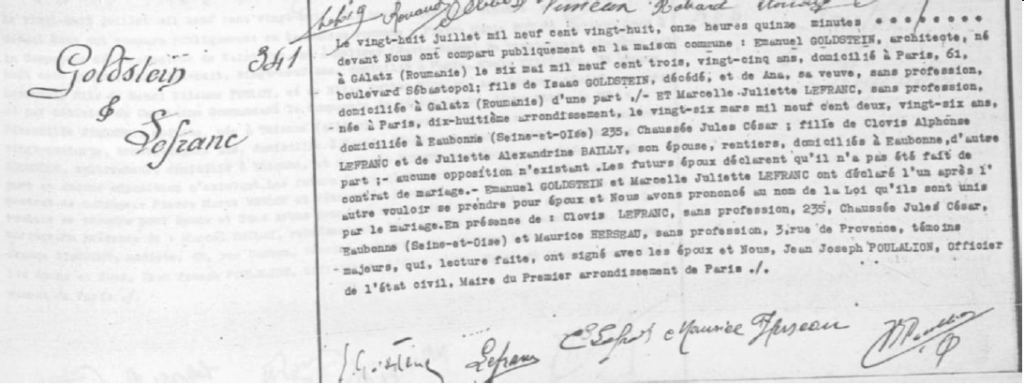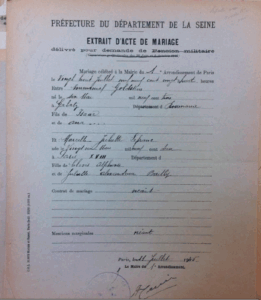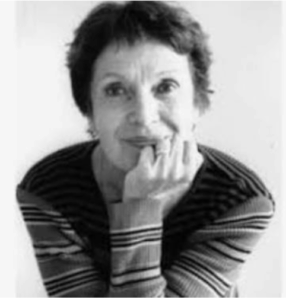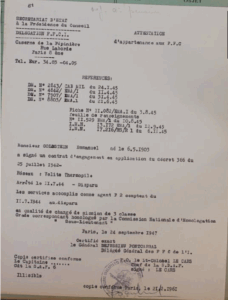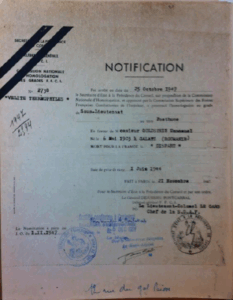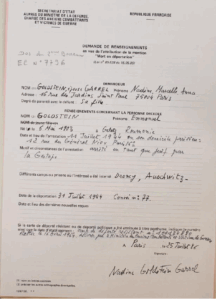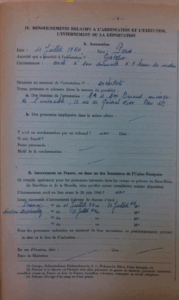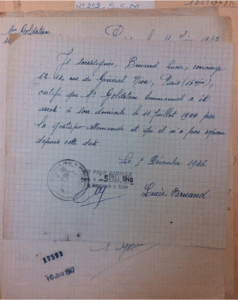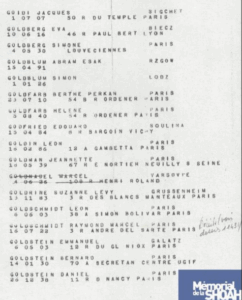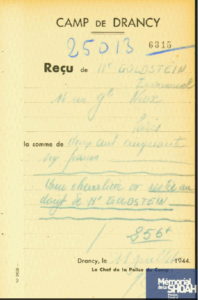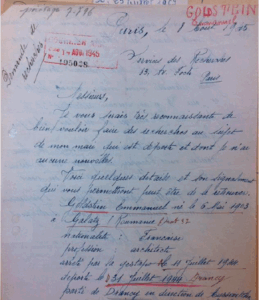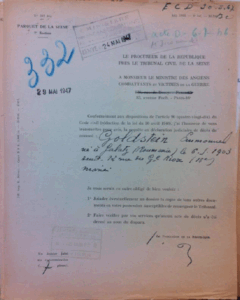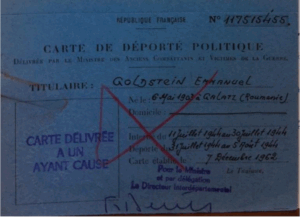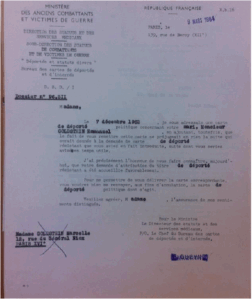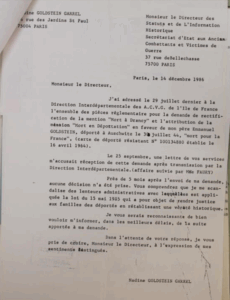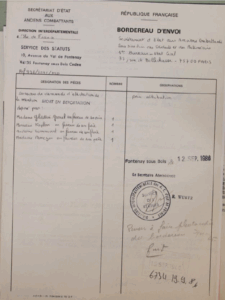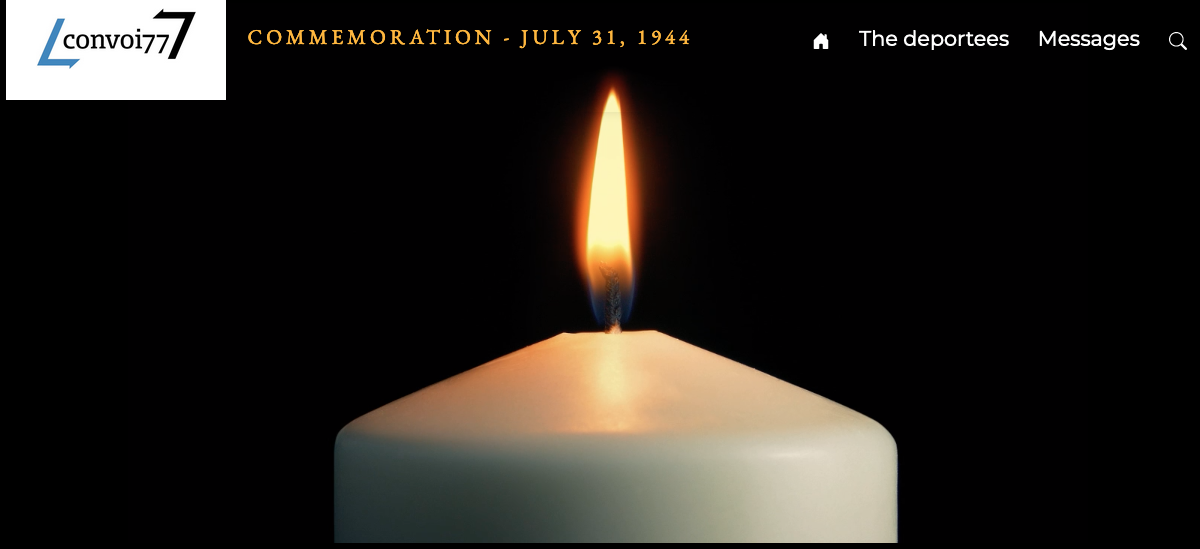Emmanuel GOLDSTEIN
Emmanuel Goldstein’s birth certificate
Source: file on Emmanuel Goldstein ©Victims of Contemporary Conflicts Archives Division of the French Ministry of Defense Historical Service, in Caen, dossier n°21P456 968.
Emmanuel Goldstein was born on May 6, 1903 in Galatz, in Romania. His parents were Isaac Goldstein and Ana Goldstein. According to Emmanuel’s daughter, they came from “a Jewish family with roots in Lithuania, Russia and Poland”. He was not a “religious” man.
We do not know exactly when Emmanuel Goldstein emigrated to France, nor for what reason. It may have been to study architecture, given that he later worked as an architect in France. When he married in 1928, his father was already dead and his mother was still living in Romania. We know this because she asked her daughter-in-law for some paperwork after the war.
Naturalization certificate
Source: file on Emmanuel Goldstein ©Victims of Contemporary Conflicts Archives Division of the French Ministry of Defense Historical Service, in Caen, dossier n°21P456 968
He was living at 61, boulevard Sébastopol in the 1st district of Paris when he married in the town hall there on July 28,1928. His wife was Marcelle Juliette Lefranc, who was born on March 26, 1902, in the 18th district of Paris. Her parents were Clovis Alphonse Lefranc and Juliette Alexandrine Bailly. When Marcelle was born, he was an electrician, while her mother was a paper maker and they were living in a rented home at 235, chaussée Jules César in Eaubonne (then in the Seine-et-Oise department of France). There was no marriage contract.
Marriage certificate
Source: ©Archives de Paris
Marriage certificate
Source: file on Emmanuel Goldstein ©Victims of Contemporary Conflicts Archives Division of the French Ministry of Defense Historical Service, in Caen, dossier n°21P456 968
The couple went on to have a little girl, Nadine (later known as Nadèjda) Marcelle Anna Goldstein, on May 23 1933, in Courbevoie, in the Hauts-de-Seine department of France. He was happy and in love: According to their daughter “They were both young, good-looking and madly in love”.
Nadèjda Goldstein (married name Garrel)
Source: www.gallimard-jeunesse.fr
Emmanuel was naturalized as a French citizen on August 11, 1937, reference number 1245 x 35.
On July 23, 1938, the family moved to 12-14, rue du Général Niox i the 16th district of Paris. This was an area that Nadèjda would later describe in her memoirs as “the wrong part of the 16th district, between Renault and Citroën”. “All around us, buildings were collapsing like houses of cards”, she wrote in 1994.
The Resistance
As required by the law at the time, Emmanuel went to register himself as a Jew and wore the yellow star. His daughter found the stigma attached to this emblem incomprehensible.
In early 1942, Emmanuel Goldstein joined the Resistance. He was a member of the Vélite-Thermopyles network, and more specifically the Patriam Recuperare (Reclaim the Country) group, which was based on a Masonic lodge. Their goal was to reinstate republican state bodies after the war was won. He was a “P 2 agent”, i.e. a permanent, paid operative available to work for the entire network.
The network was founded in 1941, by three professors/researchers at the École normale supérieure de Paris (a prestigious French university). Two of them, Pierre Piganiol and Raymond Croland, had previously been associate professors there while Albert Mercier had studied at the École normale supérieure de Saint-Cloud. Initially called Velite, it was essentially an intelligence-gathering network that reported to the B.C.R.A. (Bureau central de renseignements et d’action de la France libre, or Central Intelligence and Action Bureau of Free France).
One section of the network was disbanded in June 1943 and another in May 1944. By that time, the network had been renamed Termopyles.
Statement confirming that Emmanuel Goldstein was a member of the Vélite-Thermopyles network
Source: file on Emmanuel Goldstein ©Victims of Contemporary Conflicts Archives Division of the French Ministry of Defense Historical Service, in Caen, dossier n°21P456 968
Statement confirming that Emmanuel Goldstein was an “Agent P2″
Source: file on Emmanuel Goldstein ©Victims of Contemporary Conflicts Archives Division of the French Ministry of Defense Historical Service, in Caen, dossier n°21P456 968
Notification of rank
Source: file on Emmanuel Goldstein ©Victims of Contemporary Conflicts Archives Division of the French Ministry of Defense Historical Service, in Caen, dossier n°21P456 968
Arrest and deportation
We do not know why Emmanuel was arrested. Was it because he was Jewish, or because he was a member of the Resistance? His daughter’s request for information in 1986 suggests that it was because he was a Jew.
The only witnesses to the arrest were the building’s concierge, a Mrs. Bruand, and her husband. She stated that the German Gestapo had come to arrest Emmanuel Goldstein in his apartment at 3 a.m. on July 11, 1944, and that his wife and daughter were not there at the time.
His daughter, however, wrote “He was arrested in July 1944 by Aloïs Brunner himself and some young French militiamen”, but there is nothing to corroborate this version of events.
Request for information
Source: file on Emmanuel Goldstein ©Victims of Contemporary Conflicts Archives Division of the French Ministry of Defense Historical Service, in Caen, dossier n°21P456 968
Information relating to the arrest
Source: file on Emmanuel Goldstein ©Victims of Contemporary Conflicts Archives Division of the French Ministry of Defense Historical Service, in Caen, dossier n°21P456 968
Mrs. Braun’s witness statement
Source: file on Emmanuel Goldstein ©Victims of Contemporary Conflicts Archives Division of the French Ministry of Defense Historical Service, in Caen, dossier n°21P456 968
According to Albert Mercier, the man who closed down the Velite-Thermopyles network, some of the other agents were arrested at the same time, although not in the same place, as Emmanuel Goldstein (“in particular Gouttenoire”), “at the end of June or beginning of July 1944”.
Emmanuel was taken to Drancy camp later the same day. When he arrived, he was carrying 256 francs in cash and was wearing a gold signet ring which, according to the search receipt issued at the time “remained on Mr. Goldstein’s finger”. He was assigned prisoner number 25,013 and was interned in Drancy until July 31, 1944. He did not die in Drancy, as some records suggest. After the war, his daughter campaigned to rectify this assertion.
He was deported on Convoy 77, which left Drancy for Auschwitz-Birkenau on July 31, 1944. The journey lasted 3 days and 3 nights and was extremely arduous. In the sweltering summer heat, groups of 60 people were crammed into cattle cars. They had to stand up for most of the time, with only one bucket that served as a toilet, one bucket of water and a little bread between them.
Deported alone, without his family, Emmanuel was put in a men-only car. Several survivors’ accounts report that the men in one of these so-called “bachelor” cars attempted to escape, but failed. They must surely have been reported even before the train set off, as they were identified along the way. Stripped naked and shackled, as soon as the train arrived in Auschwitz, they were dragged onto a truck and driven straight to the gas chambers. A secret resistance group in Drancy had supplied them with a few makeshift tools. Was Emmanuel, who was already in a resistance network, approached and invited to join the men hoping to escape? Many of the deportees in the car came from North Africa, but some came from other countries.
When the convoy arrived in Auschwitz-Birkenau on August 3, 1944, the deportees were made to get out of the train onto the ramp in Birkenau, where the selection process took place immediately. Emmanuel, who had only recently arrived in Drancy and was in the prime of life, stood a good chance of being selected to go into the concentration camp for forced labor. However, there is no record of him ever having entered the camp. Another hypothesis is that as a father himself, he may have felt sorry for all the distraught, helpless children who had been dragged off the train in the middle of the night, amid SS men yelling, lights glaring and dogs barking. If he happened to take a child by the hand, then his fate was sealed immediately… he was doomed!
The Convoy 77 deportation list
Source: file on Emmanuel Goldstein ©Shoah Memorial
Drancy search receipt
Source: file on Emmanuel Goldstein ©Shoah Memorial
The family’s post-war search
After the war, Emmanuel’s wife, Marcelle, who had no idea what had happened to him, made enquiries to the authorities. In a letter dated August 1945, she expressed her disappointment with the lack of progress.
Emmanuel’s wife’s letter to the research service
Source: file on Emmanuel Goldstein ©Victims of Contemporary Conflicts Archives Division of the French Ministry of Defense Historical Service, in Caen, dossier n°21P456 968
In 1946, she received an allowance of 8,000 francs.
In a court judgement dated July 6, 1946, Emmanuel was pronounced dead, and then on January 1,1948, he was officially declared to have “Died for France”.
In 1962, his wife received a “political deportee” card in his name, numbered 117515455.
It was not until April 16, 1964 that she managed to obtained a « deported resistance fighter » card, numbered 1001.34880. By then, Marcelle Goldstein was living at 2, rue de la Montagne Sainte-Geneviève, in the 5th district of Paris.
Court judgement confirming Emmanuel’s death
Source: file on Emmanuel Goldstein ©Victims of Contemporary Conflicts Archives Division of the French Ministry of Defense Historical Service, in Caen, dossier n°21P456 968
Official declaration that Emmanuel “Died for France”
Source: file on Emmanuel Goldstein ©Victims of Contemporary Conflicts Archives Division of the French Ministry of Defense Historical Service, in Caen, dossier n°21P456 968
Resistance fighter status
In 1947, Emmanuel Goldstein was posthumously made a second lieutenant in the Resistance. He had been a member of the Forces Françaises Combattantes (French Fighting Forces), and the Forces Françaises de l’Intérieur (French Interior Forces), and as a result was granted the status of Déporté et Interné de la Résistance or Resistance internee and deportee.
According to a file on him held by the French Historical Service in Vincennes, (ref. GR 16 P 261868), the name of the Resistance network to which he belonged was “VELITE THERMOPHYLES”. In a decree dated 25 October, 1947, the FFCI national commission for the ratification of ranks stated that he had become a second lieutenant as of June 1, 1944.
A letter dated September 24, 1947 states that Emmanuel had signed a contract as a “mission officer, 3rd class, grade approved by the national approval commission”, this being the equivalent of “second lieutenant”. An announcement to this effect was published in the French Official Gazette on November1, 1947.
On July 12, 1962, Albert Mercier, one of the three founding members of the Velite-Termopyles network, confirmed that “despite his origins” (by which he presumably meant that Emmanuel was at additional risk because he was a Jew) “Goldstein at no time abandoned his duties as an agent”.
The words “Mort pour la France”, (“Died for France”) were added to his death certificate at the town hall of the 16th district of Paris, which is where he was living when he was arrested.
Emmanuel’s “Political deportee” card
Source: file on Emmanuel Goldstein ©Victims of Contemporary Conflicts Archives Division of the French Ministry of Defense Historical Service, in Caen, dossier n°21P456 968
Confirmation of “Deported Resistance fighter” status
Source: file on Emmanuel Goldstein ©Victims of Contemporary Conflicts Archives Division of the French Ministry of Defense Historical Service, in Caen, dossier n°21P456 968
His daughter, Nadèjda
As there were some factual errors in the official paperwork, such as the date and place of his death (Drancy was given), which in turn led to incorrect accounts of what happened to him life, his daughter, Nadine (Nadèjda) Goldstein (married name Garrel), campaigned relentlessly to have these mistakes corrected. She is a member of the nonprofit organization Fils et filles de déportés juifs de France (Sons and daughters of Jewish deportees from France), founded by Serge Klarsfeld, and availed of this organization to support her claims.
Letter from Emmanuel Goldstein’s daughter, Nadine Goldstein Garrel
Source: file on Emmanuel Goldstein ©Victims of Contemporary Conflicts Archives Division of the French Ministry of Defense Historical Service, in Caen, dossier n°21P456 968
Dispatch note
Source: file on Emmanuel Goldstein ©Victims of Contemporary Conflicts Archives Division of the French Ministry of Defense Historical Service, in Caen, dossier n°21P456 968
According to Wikipedia, Nadine’s mother never spoke to her about the camps, and only when she was older did she gradually find out for herself about the horrors of the Holocaust. She later became a writer of children’s and young people’s literature.
One of her books, “La Peau du ciel”, (literally “The Skin from the Sky”) published by Gallimard in 1994, is a semi-autobiographical tale that draws on her own experience and combines it with fiction. It tells the story of a little girl during the Occupation. In the anxiety-filled atmosphere of wartime, in which everything and everyone remains nameless, the protagonist sees her world slipping away: neighbors become distant, friends are threatened, the blood in the streets is quickly washed away and, most importantly, she witnesses her father’s arrest, after which he disappears, which terrifies her. Her collection of short stories, “Ils reviennent” (They return home), published in 2002 by Mercure de France, is a continuation of her reconstructed recollections. It describes the experiences of some of the deportees when came back from the camps.
Nadèjda/Nadine Goldstein Garrel died of cancer in 2003, in Varengeville-sur-Mer in Normandy, on the north coast of France. Her mother, Marcelle Goldstein, died in Eaubonne, in the Val-d’Oise department of France, on December 21, 1984.


 Français
Français Polski
Polski